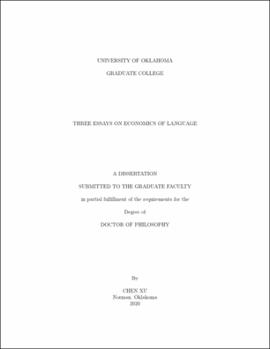| dc.contributor.advisor | Wang, Le | |
| dc.contributor.author | Xu, Chen | |
| dc.date.accessioned | 2020-07-27T19:48:17Z | |
| dc.date.available | 2020-07-27T19:48:17Z | |
| dc.date.issued | 2020-07-30 | |
| dc.identifier.uri | https://hdl.handle.net/11244/325307 | |
| dc.description.abstract | My dissertation chapters examine the Economic returns to the proficiency on language use in different contexts. The first chapter challenges some of the standard assumptions imposed in the linear ordinary least model and quantile regression model in order to estimate the English Proficiency (EP) effect on Hispanic immigrants' wages. Instead, we impose several “weaker” assumptions to nonparametrically identify the returns. There are two contributions to the existing economics of language literature. One is to use the non-parametric bounds approach to partially identify the population average treatment effects over time. The second is to bound distributional treatment effect parameters. To the best of our knowledge, this is the first paper of the economic return to language literature that employs bounds on the distributional analysis, rather than solely focusing on average mean effect. By using 2000 census data and 2010 ACS data, we find that, on average, the overall impacts are positive in both years. Yet, the effects are heterogeneous on the entire distribution. The population in the middle and upper tails benefit more from having better language skills than those in the lower tail. Finally, we find that rates of English proficiency return increase over time for most parts of the earnings distribution. By using the Pooled China General Social Survey (CGSS) data, the second chapter examines whether proficiency in English leads to higher wages in the Chinese Labor Market. We employ a non-parametric bounding method to find out the lower bound and upper bound of the average treatment effect (ATE). The nonparametric bound approach reveals that the IV estimators of English proficiency (EP) suffer from an upward bias in the study of its return on wages. Our empirical findings show sizable returns to both English listening and speaking skills, and the return is unambiguously large when one's English skills improve from the lowest to the highest level. We also find significant heterogeneity in returns to English skills. Specifically, we find English skills matter more for females, residents with urban hukou, as well as prime-aged workers. Our results here corroborate the findings in this strand of the literature that English skills, as a form of human capital, can play an important role even if they are not the official language in the country.
To shed light on the effectiveness of promoting the use of Mandarin, the third chapter analyses the economic value of Mandarin in the Chinese labor market using the 2016 wave of China Labor-force Dynamics Survey(CLDS). To address the self-selection issue, we use both instrument variable and non-parametric bounding approaches. Our results show that the overall return is positive, ranging from 10.5% to 49.9% for the whole sample. One driving mechanism we find is that workers with good Mandarin proficiency are more likely to find jobs that match their expertise, thereafter increase productivity at the workplace. We also find that the returns are heterogenous in different sub-groups. (1) Female benefit more than male, which also infers that the soft skill like language proficiency can help to reduce the gender wage gap; (2) The return is statistically significant and positive for young
and mid-age workers, but shows no enough evidence for older workers; (3) The return is larger for the urban population than rural population. In addition, we find the IV method cannot extrapolate the marginal returns along with treatment groups, and the coefficient is incredibly large which overestimates the economics return to Mandarin proficiency. | en_US |
| dc.description.tableofcontents | Chapter 1. Non-parametric bounds on quantiles under monotonicity assumptions: an application on the return to language skills among Hispanics in U.S. | |
| dc.description.tableofcontents | Chapter 2. Return to English skills in China: using a non-parametric bound approach | |
| dc.description.tableofcontents | Chapter 3. Economic value of language in China: how important is Mandarin proficiency in China labor market, from a different approach | |
| dc.language | en_US | en_US |
| dc.rights | Attribution-NonCommercial-NoDerivatives 4.0 International | * |
| dc.rights.uri | https://creativecommons.org/licenses/by-nc-nd/4.0/ | * |
| dc.subject | Economics, General. | en_US |
| dc.subject | Economics, Labor. | en_US |
| dc.subject | Economics of Language | en_US |
| dc.subject.lcsh | Economics--Language | |
| dc.subject.lcsh | Labor economics | |
| dc.subject.lcsh | Economics | |
| dc.title | Three essays on economics of language | en_US |
| dc.contributor.committeeMember | Carlson, Deven | |
| dc.contributor.committeeMember | Hicks, Daniel | |
| dc.contributor.committeeMember | Wang, Chunbei | |
| dc.contributor.committeeMember | Ransom, Tyler | |
| dc.date.manuscript | 2020-07-27 | |
| dc.thesis.degree | Ph.D. | en_US |
| ou.group | College of Arts and Sciences::Department of Economics | en_US |
| shareok.nativefileaccess | restricted | en_US |

